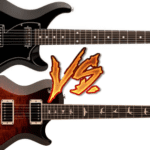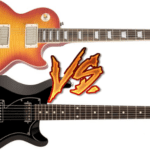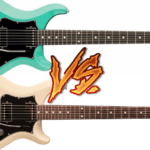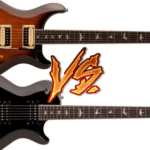Finding the particular specs of 2 guitars online is quite some work.
In many cases, the manufacturers don’t inform the same features about the instruments that you want to compare and you have to start digging all over the web to find them.
But hey, relax!
If you are here, it seems like I have already done that job for you.
Here is a brief description of these 2 guitars:
The PRS S2 Standard 22 is made in USA, has a solid mahogany body, a set Pattern Regular “C” mahogany neck, rosewood fingerboard, and HH pickups. The PRS S2 Vela is made in USA has a solid / semi-hollow mahogany body, a set Pattern Regular “C” mahogany neck, rosewood fingerboard, and HH pickups.
The PRS S2 Standard 22 has PRS Low Mass Locking tuners, PRS 85/15 “S” Humbucker pickups, and Coil-tapping electronics. The PRS S2 Vela has PRS Low Mass Locking tuners, PRS Type-D Single-coil pickups, and Coil-tapping electronics.
For those who want a deeper dive into all the specs that make these 2 guitars different, in this article I will put them side by side so you can see their main differences.
After that, I will show you some sound tests I found, and give you a brief history of each one of them.
I will then talk about their main specs one by one, and link you to some other interesting articles I have written about these specific features.
Finally, I will give you some comments about each of these instruments.
Are you ready to get started?
Let’s go!
PRS S2 Standard 22 and PRS S2 Vela side by side
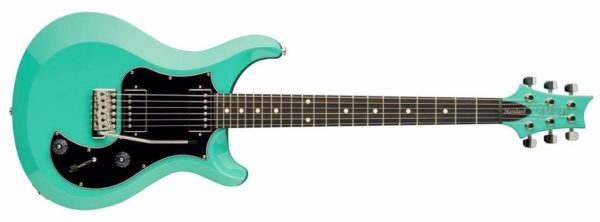
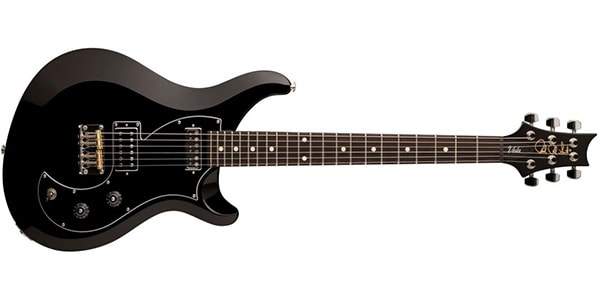
| Spec | PRS S2 Standard 22 | PRS S2 Vela |
| Years of production | Since 2013 | Since 2019 |
| Made in | USA | USA |
| Body type | Solid | Solid / Semi-hollow |
| Body shape | Double Cut | Vela |
| Body material | Mahogany | Mahogany |
| Top material | ||
| Finish | Gloss Nitrocellulose over CAB / Satin Nitrocellulose | Gloss Nitrocellulose over CAB / Satin Nitrocellulose |
| Neck material | Mahogany | Mahogany |
| Neck shape | Pattern Regular “C” | Pattern Regular “C” |
| Headstock shape | PRS | PRS |
| Neck joint | Set | Set |
| Fingerboard material | Rosewood | Rosewood |
| Fingerboard radius | 10″ | 10″ |
| Number of frets | 22 | 22 |
| Fret material | Nickel Silver | Nickel Silver |
| Fret size | Medium Jumbo | Medium Jumbo |
| Scale length | 25″ | 25″ |
| Bridge | PRS Molded Tremolo | PRS Plate-style Hardtail |
| Tailpiece | Bridge integrated | Bridge integrated |
| Nut | Synthetic/Bronze powder blend | Synthetic/Bronze powder blend |
| Tuners | PRS Low Mass Locking | PRS Low Mass Locking |
| Pickup configuration | HH | HH |
| Neck pickup | PRS 85/15 “S” Humbucker | PRS Type-D Single-coil |
| Middle pickup | ||
| Bridge pickup | PRS 85/15 “S” Humbucker | PRS Starla Humbucker (Satin solid body) / PRS Vela Humbucker (Gloss solid body, semi-hollow) |
| Electronics | Coil-tapping | Coil-tapping |
| Controls | 1 x Master Volume, 1 x Master Tone (push/pull coil-split) | 1 x Master Volume, 1 x Master Tone (push/pull coil-split) |
| Switching | 3-Way Blade | 3-Way Toggle |
| Weight | 7 – 8 lbs | 6 – 7 lbs |
| Players | Dave Navarro, Steven Wilson, Mark Tremonti, Mark Holcomb, Alex Lifeson, John McLaughlin, Paul Jackson Jr., Vernon Reid, Tyler Larson | Rob Chapman, Myles Kennedy, James Dean Bradfield, Jake Luppen, Jake Snider, Brett Campbell, Michael Gibbons |
| Case | Gig bag | Gig bag |
| Price | $1399 | $1449 |
What do they sound like?
PRS S2 Standard 22 play demo
PRS S2 Vela play demo
Brief descriptions
A brief description of the PRS S2 Standard 22
“Playing the PRS S2 Standard 22 solidbody electric guitar is a treat. The way its asymmetric bevel-cut mahogany double-cutaway shape hugs your body feels extremely comfortable, and its rosewood-capped Pattern Regular neck is a joy to wrap your hand around. Experience remarkable vintage sweetness, clarity, and extended tonal range, courtesy of the PRS S2 Standard 22’s upgraded 58/15 “S” humbuckers. Create subtle, expressive nuances, or perform full dive-bombs while maintaining perfect intonation, by virtue of this guitar’s vibrato bridge/tailpiece. The PRS S2 Standard 22 is a great-sounding, great-playing solidbody electric guitar.”
Source: Sweetwater.com
A brief description of the PRS S2 Vela
“PRS proudly introduces their new S2 Vela solidbody electric guitar. Maintaining the high-level of workmanship the company is known for, PRS has changed their recipe for the new vintage-inspired Vela. Featuring a Starla treble humbucking pickup with coil-tap and a new Type-D single-coil bass pickup, the S2 Vela aims to rock, cut, and jangle with the best of them. PRS also added a new plate-style bridge with two intonation-compensated brass saddles, delivering the classic tone and visual appeal that Sweetwater guitarists love.”
Source: Sweetwater.com

Body type
The PRS S2 Standard 22 has a solid body. The PRS S2 Vela is built with a solid / semi-hollow body.
As you probably know, the body type of a guitar is a defining factor for its character and tone.
If you want to know more about how these kinds of bodies affect these guitars, you can check out this article:

Body shape
The PRS S2 Standard 22 has a Double Cut body. The PRS S2 Vela is built with a Vela body.
The shape of a guitar’s body has serious implications on its playability, but not so much on its tone.
If you want to know everything about the effect of guitar body shapes, and their influence on the instrument, check out this article:

Body material
The PRS S2 Standard 22 has a solid mahogany body. The PRS S2 Vela is built with a solid / semi-hollow mahogany body.
The kind of material used to build a guitar’s body is something you should really pay attention to.
This is one of the main factors that define the tone of an instrument.
If you want to know how these specifics materials impact the tone of these guitars, you should take a look here:

Top material
Guitarists are often curious about how guitar tops affect tone.
There are many factors that contribute to the sound of a guitar, and whether it has a top is an important one. With so many options on the market, it can be difficult to make a decision.
The following article will explain what guitar tops are and why they matter, as well as provide guidance for those who want to learn more about these options.
In short, a guitar’s top has a slight, but perceivable, influence on its tone, however, they are mostly used for aesthetic purposes.
Whether your preferred guitar has one or not, it shouldn’t worry you too much.
However, if you want to know all there is about guitar tops, go here:

Finish
The PRS S2 Standard 22 has a gloss nitrocellulose over cab / satin nitrocellulose finish. The PRS S2 Vela is painted with a gloss nitrocellulose over cab / satin nitrocellulose finish.
Guitar players know that there are many variables in determining the sound of a guitar. Yet, one of the most popular debates is about nitro vs poly.
Let’s explore this question, so you can make an informed decision for your next purchase.
These 2 finishes are both types of varnish that can be used to protect and beautify a guitar’s wood. They also have slightly different properties that some players argue can influence the tone of your guitar.
Nitro is a type of varnish that is thinner and less durable, while poly is thicker, way more durable, and cheaper.
Poly provides more protection from moisture and scratches, but some people argue it reduces resonance and sustain. Nitro wears off with time but has a more organic feel to the touch and is said to improve sustain and resonance.

Neck material
The PRS S2 Standard 22 has a mahogany neck. The PRS S2 Vela is built with a mahogany neck.
The type of wood that a guitar neck is made of will have a significant impact on the tone of your guitar.
Tonewoods have different densities, hardness, and acoustic qualities.
The type of wood a guitar neck is built with will determine its final sound.
In the following article I present you a list of the most common tonewoods used in guitar necks, and the influence they could have on the tone of the instrument:

Neck shape
The PRS S2 Standard 22 has a Pattern Regular “C” neck. The PRS S2 Vela is built with a Pattern Regular “C” neck.
The shape of a guitar neck has a significant impact on the tone and playability.
Guitar necks come in a variety of shapes, so it’s important to know what each of those shapes offers.
Luckily for you, I’ve compiled some general information about each different type of guitar neck shape so you can make an informed decision when choosing your next guitar:

Headstock shape
The PRS S2 Standard 22 has a PRS headstock. The PRS S2 Vela is built with a PRS headstock.
The shape of a guitar’s headstock is not really a big defining factor for its tone.
However, many players argue that differences in mass, especially at the end of the neck can have some implications in tone.
In this article I go deep into that topic and answer the most pressing questions:

Neck joint
The PRS S2 Standard 22 has a set neck. The PRS S2 Vela is built with a set neck.
Guitar necks come in a variety of different joints, and each one has its own pros and cons.
Knowing the differences between each joint can help you decide which is best for you.
A guitar’s neck joint is what attaches the guitar’s neck to the body of the instrument.
There are 3 types of neck joints: bolt-on, set, and neck through.
Bolt-on necks are attached by screws at the heel of the neck and can be removed easily for repairs or customization.
Set necks attach to a pocket in the guitar’s body and stay put with glue.
In neck trough instruments, the neck elongates and becomes the central piece of the body, where most of its hardware is mounted. Then, there are wood “wings” glued to its side to complete the body shape.
If you want to know the specifics of each of these joints, check out this article:

Fingerboard material
The PRS S2 Standard 22 fretboard is made of rosewood. The PRS S2 Vela fretboard is built of rosewood.
The material of a guitar’s fingerboards is as important as the one of the rest of the neck.
In conjunction, both these 2 parts have a deep impact on the final tone of the instrument.
Also, take into consideration that the fretboard is the point of contact for your playing fingers with the guitar, so feel is also a very important factor.
In the following article, I share my thoughts on different fingerboard materials and their impact on the final sound of the instrument:

Fingerboard radius
The PRS S2 Standard 22 has a 10″ radius. The PRS S2 Vela is built with a 10″ radius.
The radius of the fingerboard is a measure of how curved the neck of the guitar actually is when looking at it from bridge to nut.
This curvature is really a defining factor for how the instrument plays, and some players are very strict about it.
If you want to know more about how it’s measured and the effect it has on the playability of a guitar, you should look at the following article:

Frets
The PRS S2 Standard 22 has 22 medium jumbo nickel silver frets. The PRS S2 Vela is built with 22 medium jumbo nickel silver frets.
The frets on a guitar have a deep impact on its playability.
Many players don’t consider this as important as other features, but more experienced ones will be very picky about this.
Bigger frets make a guitar easier to play, however, they hinder the overall intonation of the instrument.
Also, there are different fret materials to consider.
In these articles, I dive deep into how important are frets for a guitar.

Scale length
The PRS S2 Standard 22 has a 25″ scale length. The PRS S2 Vela is built with a 25″ scale length.
The scale length of a guitar refers to the longitude of the vibrating part of the string.
This is measured from the nut to the bridge, and for intonation purposes, the middle point is always the 12th fret.
Different scale lengths have varying influences over things such as string tension, and of course, fret gap size.
If you want to know more about this, I invite you to read the post below:

Bridge
The PRS S2 Standard 22 has a PRS Molded Tremolo bridge. The PRS S2 Vela is built with a PRS Plate-style Hardtail bridge.
A guitar’s bridge is one of the 2 points of contact the strings have with the body and neck.
It is a central part for the transmission of vibrations through the instrument, and also defines many important factors for playability such as string spacing and action.
Some bridges also have extra functionalities.
To know everything there is about this part of the guitar, please go here:

Tailpiece
The PRS S2 Standard 22 has a bridge integrated tailpiece. The PRS S2 Vela is built with a bridge integrated tailpiece.
Tailpieces are often forgotten when thinking about guitar parts, however, they have been there for centuries, and there are many different designs with alternate features.
Whether your guitar has a standalone one or a bridge that works like one too, you might be interested in broadening your knowledge about tailpieces here:

Nut
The PRS S2 Standard 22 has a synthetic/bronze powder blend nut. The PRS S2 Vela is built with a synthetic/bronze powder blend nut.
The nut of a guitar is a small but very important part of the instrument.
It helps define string spacing, action, and is the source of many of the tuning issues cheaper instruments suffer from.
There are many kinds and materials of nuts out there, and if you want to know how they can impact your instrument of choice, you should go to this article:

Tuners
The PRS S2 Standard 22 has PRS Low Mass Locking tuners. The PRS S2 Vela is built with PRS Low Mass Locking tuners.
Guitar tuners don’t have a direct effect on how a guitar sounds.
However, their quality will be a defining factor in your playing experience.
It’s fundamental that your instrument has good quality machine heads to keep it in tune.
In the following article, I dive deep into the most common questions players ask about tuners, and their functionality:

Pickups
Guitar pickups are one of the main components of any electric guitar.
But do guitar pickups make a difference in sound? This can be a difficult question with many different answers.
The most important thing to note is that it is not just the type of pickup that determines a guitar’s sound, but also how and where you place the pickup on the guitar.
In this guide, we will discuss the different types of pickups and how they affect your sound.
We will outline how pickups work and what are the central factors that determine how they influence the tone of your instrument.
Finally, we will help you compare different models and make an informed decision about which pickup is right for you.

Electronics
The PRS S2 Standard 22 has coil-tapping electronics, 1 x master volume, 1 x master tone (push/pull coil-split) controls, and a 3-way blade switch. The PRS S2 Vela is built with coil-tapping electronics, 1 x master volume, 1 x master tone (push/pull coil-split) controls, and a 3-way toggle switch.
The electronics of an electric guitar are what gives the instrument its name. However, because they are hidden inside the cavities into its body, they are often forgotten.
Controls, switches, capacitors and resistances, all make for the circuitry of a guitar, and all have effects on the final tone and sounds it can offer to the player.
If you want to know the main things about this topic, I recommend you follow this link:

Weight
The PRS S2 Standard 22 weighs 7 – 8 lbs, and the PRS S2 Vela weighs 6 – 7 lbs.
Guitar weight is an important factor when it comes to finding the right guitar for you.
A heavier guitar will give you more sustain, but a lighter guitar will be more resonant, and easier to play and carry around.
However, there’s no single answer to whether a lighter or heavier guitar will sound better than the other.
There are also many factors that could determine what weight of guitar would be best for you.
Here, I explore some of these considerations and what I think are the main points to take into account:
Final comments
The PRS S2 Standard 22 is a great entry point to the PRS American lineup, especially if you consider the cheaper satin finish option. For some extra bucks you can get the gloss finish if that’s your preference.
The PRS S2 Vela is a wonderful alternative in the S2 lineup, available in semi-hollow versions, and solid body satin and gloss alternatives, each with slight differences, but overall preserving the elegant, vintage-inspired spirit of the model.
Which one do you think you like better?

Hello there, my name is Ramiro and I’ve been playing guitar for almost 20 years. I’m obsessed with everything gear-related and I thought it might be worth sharing it. From guitars, pedals, amps, and synths to studio gear and production tips, I hope you find what I post here useful, and I’ll try my best to keep it entertaining also.


